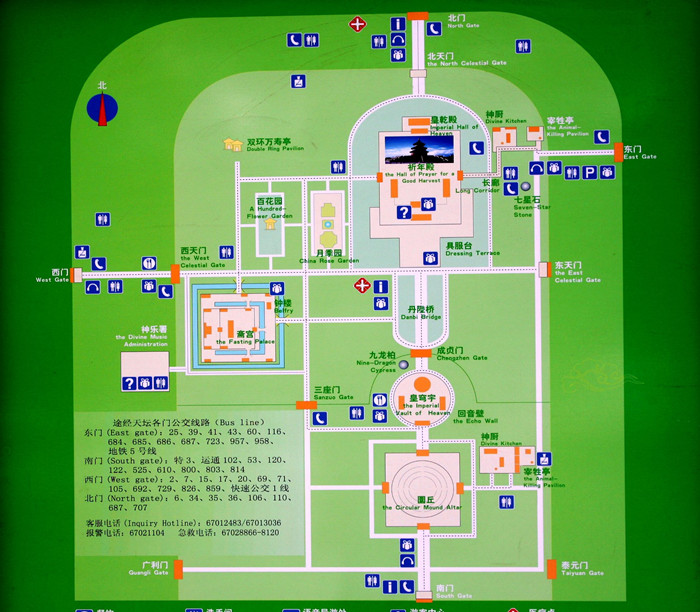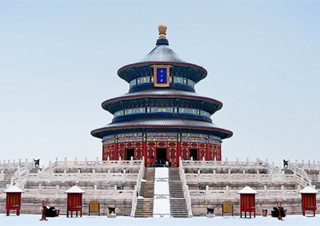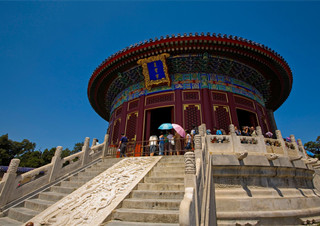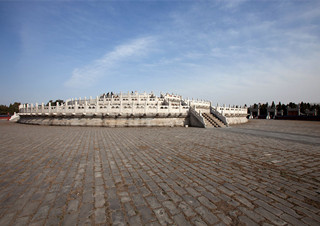- 86-15907880780
- contact@youngchinatravel.com
Located on the east side of Yongdingmen Inner Street, Chongwen District, the Temple of Heaven (Tiantan Park) is the largest of all parks in Beijing with an area of 667 acres (269.9 ha.). It was founded in the 18th year under the reign of Yong Le of the Ming Dynasty (1642), where the emperors of Ming and Qing dynasties performed the ceremony of offering sacrifice to Heaven. The park covered with ancient pines and green cypresses many of which are over five hundred years. The main buildings in this park are a group of temples which are noted for their exquisite layout, harmonious color, and unique structure, including the Hall of Prayer for Good Harvest (Qiniandian), the Imperial Vault of Heaven (Huangqiongyu) and the Circular Mound Altar (Yuanqiutan) and so on. They are one of the most beautiful architectural achievements in the world and an out-standing masterpiece of traditional Chinese architecture. Precise layout, fantastic structures and magnificent decorations of the Temple of Heaven are the most impressive.
This group of temples was built at the same time as the Imperial Palace (1406-1420 A.D.). The feudal emperors who called themselves "the sons of heaven" held ceremonies to worship heaven every year and the Temple of Heaven was built just for this purpose.
The Temple of Heaven, 1700 metres long from east to west and 1600 metres wide from south to north with a total area of 2,730,000 square metres, is enclosed with two circled walls. The northern part of the walls is semicircular, symbolizing the heaven, and the southern part is square, symbolizing the earth. Such design reflects an ancient Chinese thought of "The heaven is round and the earth is square". No gate is furnished on the east, south and north sides of outer wall except two gates (Yuanqiutan and Qigutan gates) on the west side. Around inner wall there are four gates respectively on the east, south, west and north sides. Sacrificial altars and Fast Palace are in inner part, which is divided into two blocks by a transverse wall. On the south of the wall is the Circular Mound Altar (Yuanqiutan). On the north of the wall is the Altar of Prayer for Good Harvests (Qigutan). The Temple of Heaven covers a vast expanse of land, equal to four times of the Forbidden City. Around the structures that only occupy a very small area of land are pines and cypresses of dark green. Such colour meant respect, memorial and praying in ancient time. That is why pines and cypresses are often planted in altars, temples and mausoleums.
Entering the western gate of the Temple to the right there is a path which leads through the trees to the Hall of Abstinence. The Hall is a group of buildings surrounded by a square enclosure and a moat. This section of the Temple of Heaven is presently not open to visitors.
Continuing along the entrance path one comes to a raised passage called the Red Stairway Bridge.
This broad walk connects the two sets of main buildings in the Temple of Heaven enclosure. On this Red Stairway Bridge there is a platform to the east. It is the place where the emperors changed clothing before going to worship.
Turning northward and entering through the Gate of Prayer for Good Harvest.

The feature building of the Temple of Heaven is the Hall of Prayer  for Good Harvest (Qiniandian). With a height of 38 metres and a diametre of 30 metres, it is a big cylinder-shaped palace based on a three-layer round masonry pedestal with round roof and three layers of eaves. The three layers of eaves are all paved with dark blue glazed tiles, and decrease in layer by layer. On the top of the building is a gigantic gold-plated cap. White pedestal represents white clouds. Dark blue roof represents heavens. Posts, coloured paintings and gold-plated head represent rosy clouds.
for Good Harvest (Qiniandian). With a height of 38 metres and a diametre of 30 metres, it is a big cylinder-shaped palace based on a three-layer round masonry pedestal with round roof and three layers of eaves. The three layers of eaves are all paved with dark blue glazed tiles, and decrease in layer by layer. On the top of the building is a gigantic gold-plated cap. White pedestal represents white clouds. Dark blue roof represents heavens. Posts, coloured paintings and gold-plated head represent rosy clouds.
The hall is one of the highest buildings in Beijing at that time. The Hall of Prayer for Good Harvest was first built in the 18th year under the reign of Yong Le of the Ming Dynasty (1420), and known as Dasidian at that time with square body, yellow-tile roof and multiple eaves. However, it was dismantled under the instruction of Emperor Jia Jing later. In 1545, a cylinder-shaped hall, known as Daxiangdian, was built at former site. Since founding of the Qing Dynasty, it was used to held rites to pray for good harvest, and was rebuilt in the 16th year under the reign of Qian Long of the Qing Dynasty (1751) with blue tiles paved on the roof and a gold head mounted on the top. At the same time, Daxiangdian was officially renamed as Qiniandian. In the 15th year under the reign of Guang Xu of the Qing Dynasty (1889), the Hall of Prayer for Good Harvest, unfortunately, was burned due to lightning stroke. Since columns and posts are made of sandal woods, the fire spread the fragrance of the woods over several miles. According to a popular saying, there are four treasures in Beijing ancient building material market, that is, the columns and posts of sandal wood from the Hall of Prayer for Good Harvest, the girders and posts of eaglewood from the front hall of Supreme Ancestral Temple, the lofty columns of lignum vitae from the Pavilion of the Fragrance of Buddha (Foxiangge), and the panes of sandal wood from the Hanyuan Hall of the Garden of Harmonious Interest (Xiequyuan). Existing hall was rebuilt after lightening stroke with same outline and structure with the former one.
Without the use of steel, cement and nails, even without the use of big beams and crossbeams, the entire structure of the Hall of Prayer for Good Harvest—38 metres high and 30 metres in diameter—is supported by 28 massive wooden pillars and a number of bars, laths, joints and rafters, which are integrated into a reinforced frame to prop up the bulk of the Hall. The four central pillars, called the Dragon-Well Pillars, are 19-2 metres high, and so big that each will take two and a half men to encircle it with their arms stretched out. They represent the four seasons. There are two rings of twelve pillars each, the inner ring symbolizing the twelve months and the outer ring the twelve divisions of the day and night. The pillars, 28 in number also represent the 28 constellations in the sky. The timber for making these pillars was shipped all the way from Yunnan Province in Southwest China. The centre of the stone-paved floor is a round marble slab with a natural pattern of dragon and phoenix. On the right (east) there used to be two sets of screens, two chairs and a long table. The tablets of the emperor's ancestors were placed on the table, which is now on display. On your left (west) the emperor used the chair to take a rest after the service.
The day before praying for good harvests, the emperor came to the Hall of Imperial Zenith just behind this hall to present incense and then came here to inspect the tablets. The tablet of the God of Heaven was kept in the shrine while other tablets were placed on the stone platform. He then left by the left side gate for the Storehouse of the Gods to inspect sacrificial articles before he returned to the Hall of Abstinence.
On the day of the prayer, the emperor worshipped the God of Heaven. Fire was built in the oven to usher in the God of Heaven. The emperor presented white silk and three courses of dishes to the God. Finally, the silk and food were taken away, followed by music and dance.
Five thousand dragon designs are decorated on the inside and outside of the Hall of Prayer for Good Harvests. They are very sumptuous, and colours are natural and harmonious. They are suited to the occasion.
The circular wooden hall is popular with photographers, owing to its unique architectural style. But the interior framework is far more distinctive.
Going out of the gate of the Hall of Prayer for Good Harvests, visitors come to a raised passage 360 metres long, 30 metres wide and 4 metres high. This broad walk, called Red Stairway Bridge connects the two sets of main buildings in the Temple of Heaven.
In the middle of the passage there is a platform on the eastern side. This is where the emperor changed his clothes before going to worship.
To the south lie the Imperial Vault of Heaven and the Circular Mound Altar. These three buildings are arranged in a straight line. An aerial view of the enclosure will show that the wall to the south is square while the one to the north is semi-circular. Such a pattern represents the ancient belief that heaven was round and the earth square.
The Imperial Heavenly Vault is the main building  in the southern part of the Temple of Heaven. Though smaller than the Hall of Prayer for Good Harvests, it is extremely exquisite in design. Seen from a distance, it looks like a blue umbrella topped with a gilded ball. Inside the hall in the center stands a shrine where the tablet of the god of Heaven was placed. There are four stone platforms on each side, where the tablets of the emperor's ancestors of eight generations used to be kept. On winter solstice every year, these tablets would be removed to the Circular Mound Altar for the ceremony of worshipping Heaven.
in the southern part of the Temple of Heaven. Though smaller than the Hall of Prayer for Good Harvests, it is extremely exquisite in design. Seen from a distance, it looks like a blue umbrella topped with a gilded ball. Inside the hall in the center stands a shrine where the tablet of the god of Heaven was placed. There are four stone platforms on each side, where the tablets of the emperor's ancestors of eight generations used to be kept. On winter solstice every year, these tablets would be removed to the Circular Mound Altar for the ceremony of worshipping Heaven.
The Imperial Heavenly Vault was built in 1530 during the Ming Emperor Jiajing's reign. It is 19.5 meters high and 15.6 meters in diameter. Its structure is about the same as the Hall of Prayer for Good Harvest, only wood and bricks were used. Its characteristics are as follows: the ceiling is relatively small; there is not a single cross-beam; the whole structure is supported by eight pillars and a span-work of bars, laths, and brackets, which is in complete conformity with the principles of dynamics. Its two hundred year old decorative paintings were restored in 1974. The points of interest here are the Echo Wall and the Triple Sound Stone. The Echo Wall is a round wall surrounding the Imperial Heavenly Vault. It is 3.72 meters high, 90 centimeters thick and 65.1 meters in diameter. It is so called because a mere whisper at any point close to it will send the sound travelling along the wall so that the echo can be heard clearly at any other point of the wall. This is made possible because the wall is round, it has eaves and all the bricks are hermetically laid.
In front of the steps leading down from the Imperial Heavenly Vault is San Yin Shi, Triple Sound Stone. If a person stands on the first stone and calls out, the sound will be echoed once, on the second stone the echo will be heard twice, and on the third stone, the sound will be repeated three times. As a matter of fact, the echoes are resounded more than three times, but cannot be heard distinctly after the third time. This phenomenon is due to the differences in the distance which the sound waves have to travel from the stone to the Echo Wall. As a result, the sound waves returning at different intervals create different echoes.
South of the Echo Wall stands the Circular Mound Altar, which is wholly built of white marble. The two separate walls enclose the altar. A square wall is outside and a round one being inside. Its layout forms a geometrical pattern but the structure itself is so designed as to make the most ingenious use of geometry. The altar is 5 metres high. The upper terrace is 30 metres in diameter, the middle terrace 50 metres and the bottom terrace 70 metres- Each terrace has four entrances and a flight of nine steps leading down in every direction. At the centre of the upper terrace lies a round stone surrounded by nine concentric rings of stones. The number of stones in the first ring is 9, in the second 18, and so on, up to 81 in the 9th ring.
The middle and bottom terraces also have 9 rings each. The total number  of the marble slabs paved on the altars surface is 3,402. Even the numbers of the carved balustrades on these terraces are also the multiples of 9. The number of the balustrades is 360, which stands for the 360 degrees of the circumference of heaven. When you stand in the centre of the upper terrace and speak in a low voice, your echo will sound much louder to yourself than to others, as the sound waves are sent back by the marble balustrades to focus at the centre.
of the marble slabs paved on the altars surface is 3,402. Even the numbers of the carved balustrades on these terraces are also the multiples of 9. The number of the balustrades is 360, which stands for the 360 degrees of the circumference of heaven. When you stand in the centre of the upper terrace and speak in a low voice, your echo will sound much louder to yourself than to others, as the sound waves are sent back by the marble balustrades to focus at the centre.
The altar was built in 1530, and rebuilt in 1740 in the Qing Dynasty (1644-1911). Although it is over 200 years old, the structure still stands perfectly erect without sagging or cracking.
Every year on Winter Solstice, escorted by soldiers and officials, by musicians and by princes of the royal blood, the emperor would come here to make solumn sacrifice. From the Front Gate to the entrance of the Temple, each gate and every window overlooking his route had to be closed tight. No foreigners were allowed to watch the procession and foreign diplomats were officially advised to stay in their quarters that day. It even happened that the train from Tianjin was forced to stop so as not to disturb the silence of the ceremony.
The emperor spent a night of fasting and praying in the Temple. The King of Zhou, claiming to be the son of Heaven, made the first offer to Heaven 3,000 years ago. Yuan Shikai ( 1859-1916), a warlord, made the last sacrifice to Heaven in 1914. Southeast of the Circular Mound Altar stands an oven built of glazed tiles. It was used as a sacrificial vessel for roasting ox and sheep, etc. Southwest of the Altar is a viewing lantern platform, on which a big pole was fixed for hanging big lanterns during ceremonies.
The Temple of Heaven is a bright pearl of Chinese ancient buildings, and a treasure of World architectural history. It is a national cultural heritage under special protection, and listed by UNESCO as a World Cultural Heritage Site.